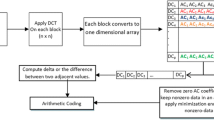Abstract
This paper details a compression system for stereoscopic (3-D) images that takes advantage of the disparity compensation effect by heavily compressing one image and a lightly compressing the other. Two methods were tried for the creation of the heavily compressed image: Lossy Pyramid coding and Pruned Discrete Cosine Transform (PDCT) with Variable Length Coding VLC. Both versions of the program used a lightly quantized PDCT image for the “clear” image.
A detailed explanation of the algorithms, the effect of compression level, and the effect of compression method on stereoscopic perception is presented. A method of creating a pseudo 3-D image from a single image is also discussed.
Similar content being viewed by others
References
N.Ahmed and K.R.Rao, Orthogonal Transforms in Digital Signal Processing, Springer-Verlag: New York, 1975.
J.Avishai et al., “Performance consequences of two types of stereo picture compression,” Human Factors, Vol. 32, No. 2, pp. 173–182, 1990.
J.Burt and E.H.Edelson, “The Laplacian pyramid as compact image code,” IEEE Transactions on Communications, Vol. COM-31, No. 4, pp. 532–540, 1983.
I.Dinstein et al., “On the compression of stereo images: Preliminary results,” Signal Processing, Vol. 17, pp. 373–382, 1989.
J.Dinstein et al., “Compression of stereo images using subsampling and transform coding,” Optical Engineering, Vol. 30, No. 9, pp. 359–1364, Sept. 1991.
M. El-Sharkawy and W. Eshmawy, “A fast recursive pruned DCT for image compression applications,” 37th Midwest Symposium on Circuits and Systems, pp. 887–890, 1994.
H.Hou, “A fast recursive algorithm for computing the discrete cosine transform,” IEEE Trans. ASSP, Vol. ASSP-35, pp. 1455–1461, 1987.
B.G.Lee, “A new algorithm for discrete cosine transform,” IEEE Trans. Acoust., Speech, Signal Processing, Vol. ASSP-32, pp. 1243–1245, 1984.
MPEG standard ISO/IEC reference number 11172-2 1993(E) First Edition 1993-08-01.
Z. Wang, “Pruning the fast discrete cosine transform,” IEEE Transactions on Communication, Vol. 39, No. 5, 1991.
Author information
Authors and Affiliations
Rights and permissions
About this article
Cite this article
Meyer, B., El-Sharkawy, M. Compression of stereoscopic images using pyramid and prune DCT encoding. Multimed Tools Appl 3, 33–53 (1996). https://doi.org/10.1007/BF00403083
Issue Date:
DOI: https://doi.org/10.1007/BF00403083




